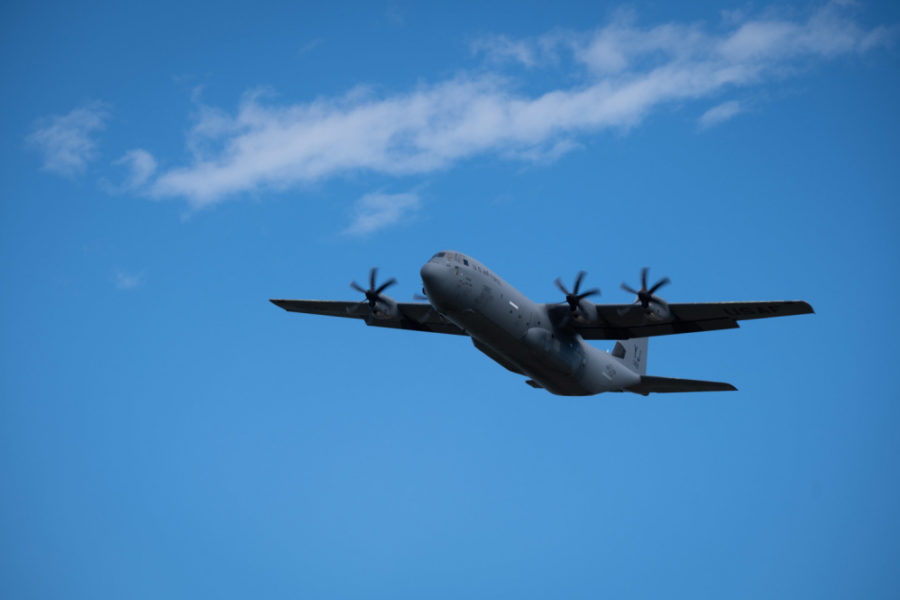The C-130J is the redesigned, current production version of the C-130 all-purpose theater transport. Missions include tactical and intertheater airlift, airdrop, AE, and wildfire suppression using the Modular Airborne Fire Fighting System (MAFFS), and humanitarian relief. The aircraft first deployed to combat in Southwest Asia in 2004.

The Super Hercules features three-crew flight operations, more powerful engines, composite six-blade propellers, and digital avionics and mission computers.
The C-130J can fly faster, higher, and farther than the C-130H. The C-130J-30 variant features a 15-foot-longer “stretched” fuselage. The combined fleet is sustained via block upgrades. USAF combined Block 7/8.1 upgrades to reduce modification downtime.
Block 7 includes Link 16, new flight management systems, civil GPS, and a special mission processor. Ongoing Block 8.1 upgrades add improved LOS data link and BLOS comms, improved precision navigational aids, enhanced covert lighting, replace UHF comms with SATCOMS, and update mission planning systems. Block 8.1’s Mode 5 IFF and air traffic management upgrades were successfully fielded ahead of cycle to meet airspace requirements and the first full 7/8.1 aircraft was redelivered in late 2020 with 15 slated for upgrade in FY24.
Airframes delivered since 2009 incorporate enhanced service-life center wings, and three early production airframes will be retrofitted in 2024. Major development focuses on modernized secure, jam-resistant HF/UHF/SATCOM voice and data (MUOS and NATO Saturn) as well as data links to keep pace with newer satellites and networking. Congress added funds beyond the current multiyear C-130J contract, including 16 C-130Js for the ANG units and four for AFRC, bringing planned C-130J procurement to 202 aircraft.
Four former EC-130J Super-Js are undergoing deconversion to standard C-130Js and will be redelivered to Little Rock by late 2027. AFRC successfully flight-tested the Electronic Modular Aerial Spray System (EMASS) on a C-130J at Youngstown in March 2024, paving the way for the J-model to take over the aerial spray mission from the C-130H. The Georgia ANG transitioned from the C-130H to the C-130J in 2023 and USAF announced plans to transition units in Connecticut, Montana, Minnesota, and Illinois to the Super Hercules.
Contractor: Lockheed Martin.
First Flight: April 5, 1996.
Delivered: February 1999-present.
IOC: October 2006.
Production: 2,600+ worldwide, 134 (USAF).
Inventory: 151
Operator: AETC, AMC, PACAF, USAFE, ANG, AFRC.
Aircraft Location: Dyess AFB, Texas; Keesler AFB, Miss.; Little Rock AFB, Ark.; Ramstein AB, Germany; Yokota AB, Japan; and ANG in California, Georgia, Kentucky, Rhode Island, Kentucky, Texas, and West Virginia. Planned: Youngstown ARS; ANG in Arkansas, Connecticut, Montana, Minnesota, and Illinois.
Active Variants: •C-130J Super Hercules. Current production version. •C-130J-30 Super Hercules. Stretched version capable of accommodating larger loads.
Dimensions: Span 132.6 ft, length 97.8 ft, height 38.8 ft.; J-30 length 112.8 ft. Weight: Max T-O 155,000 lb (J), 164,000 lb (J-30); max payload 42,000 lb (J), 44,000 lb (J-30).
Weight: Max T-O 155,000 lb (J), 164,000 lb (J-30); max payload 42,000 lb (J), 44,000 lb (J-30).
Power Plant: Four Rolls-Royce AE2100D3 turboprops, each 4,700 shp.
Performance: Speed 417 mph (J), 410 mph (J-30); range with 35,000 lb payload 1,841 miles (J), 2,417 miles (J-30).
Ceiling: With max payload, 26,000 ft (J), 28,000 ft (J-30).
Accommodation: Two pilots, loadmaster.
Load: Up to 92 combat troops or 64 paratroopers or 74 litters or six cargo pallets or 16 Container Delivery System (CDS) bundles or any combination of these up to max weight (J); 128 combat troops or 92 paratroopers or 97 litters or eight pallets or 24 CDS bundles or any combination of these up to max weight (J-30).
